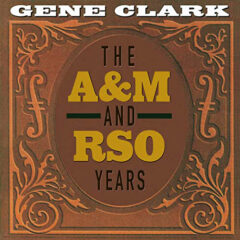

The American singer-songwriter can be a singularly isolated figure along the historical musical landscape. The songwriters who don’t achieve stardom or some measure of commercial success in their lifetime are often forgotten or over-identified with one period of their careers. Such was the life and gifted nature of Byrd co-founder Gene Clark.
A lonely artist who nonetheless loved his peers and friends, he wrote and sang from a place of authenticity and truth. Clark was arguably the principal and finest songwriter of the Byrds, the mid-’60s rock band that forged a prominent legacy in the music of the decade. Clark, however, never came close to reaching the kind of heady success of his time with the Byrds. Add to this, the horrible, tortured pain brought on by alcohol addiction and he has emerged as one of the most overlooked and least-remembered tragic artists of his era. He remains the Hank Williams of country-rock. He was a country poet gentleman who explored the heartbreak and brokenness of the human condition. He lived it as well.
He is also a pioneer of today’s Americana music scene. This became clear with the historical 2014 tribute concert to his epic, forgotten masterpiece album, 1974’s No Other, led by alt-rockers Beach House, Fleet Foxes, and Grizzly Bear. The album has given Clark newfound status as a work that brought him credence as an innovative, visionary artist. With this album, he joined the company of the Band and the late ’60s Beach Boys in defining a new fusion of American roots music. None of his Byrds mates has been able to touch it. It is that masterful.
The 2020 release, Gene Clark: The A&M and RSO Years, represents Clark’s post-Byrds years with Doug Dillard and the Dillard & Clark Expedition through the critically successful Jesse Ed Davis produced classic, White Light, and 1973’s Roadmaster, which became the ramp up to No Other, while his RSO uneven effort, Two Sides to Every Story (1977) spells out the disappointment and career disorientation that followed the commercial failure of No Other.
Even during his continued struggles with addiction and the subsequent depression, Gene Clark built on his singer-songwriter credo and Byrds legacy to end his short career with collaborative gems like So Rebellious a Lover with Carla Olson. He found limited success with a short-lived Byrds reunion in 1973 and collaborations with McGuinn and Hillman later in the decade as well.
But, with his diamond-like voice and gentle approach to songwriting, even at his most collaborative, Gene Clark seemed alone in the crowd of friends, family, and fans who supported him. Even his talent set him apart from the crowd. Although as a songwriter he was often equal to Bob Dylan and Neil Young, the crowds never arrived to sing his praises during his lifetime. But, few could equal the heartfelt soul of songs like “She Don’t Care About Time,” “Siver Raven,” “For a Spanish Guitar,” and “Del Gato.” Dylan once said he would have been proud to have written: “For a Spanish Guitar.”
This current collection may be a place to begin for the newly born Byrds novice. It is nicely packaged, mastered, and compiled, but without the triumph of No Other, the listener will miss a major part of Clark’s artistic development. It would be like the Beach Boys minus Smile and Pet Sounds or the Beatles without Rubber Soul or Sgt. Pepper’s Lonely Hearts Club Band.
But, as it is, The A&M and RSO Years brings together some of Gene Clark’s finest songs and will undoubtedly yield a desire to hear more from one of rock’s forgotten icons. If so, go directly to the first Byrds albums and the 1974 masterpiece. It is worth mentioning, engraved on Harold Eugene Clark’s gravestone are the words, “No Other.” Indeed, with a complete listen to Gene Clark’s musical legacy the truth of these words remains timeless.